This healthy snacks guide won’t be your typical FuzzBeed listacle about 99 healthy snacks to get absolutely shredded this year, though getting absolutely shredded is certainly a possibility. Instead of running through foods you already know you should be eating, my hope is to provide a fresh look at different snacks for each macronutrient group and give a bit of background on the how and why behind my snack recommendations.
I’ll kick things off below with a brief introduction to macronutrients and the CliffsNotes on snacking for optimizing body composition. Hopefully, this introduction helps every recommendation make a bit more sense and fit into one big cohesive guide. If you get tired of my jabbering, feel free to use the list below to jump to any section for the snacks and recipes in an easy-to-save format.
- High Protein Snacks
- Low Calorie Snacks That Are Primarily Carbs
- Healthy Fats and Snacks for Low Carb Diets
- High Protein Sweet Snacks
- Healthy Chips and Dip Snack Recipes
- Healthy Pizza Recipes for Snacking
- Rotisserie Chicken Snack Recipes
- Low Calorie Cauliflower Snacks
- High Protein Popcorn & Candied Nuts for Snacking
- Snack Options for the Mid-Morning Snacker
- High Protein Appetizers and Snacks
Okay, let’s dive in.

What You Need to Know About Macronutrients
I could care less what kind of diet you use as long as your overall strategy aligns with your goal. Or simply put, if you want to lose body fat, you should be eating fewer calories than you expend each day. And if you want to gain muscle or body weight, you should be eating slightly more calories than you’re expending. What those calories are comprised of is entirely up to you.
That being said, evidence suggests there are strategies more optimal than others for body composition. Namely, macronutrient ratios and protein content in hypocaloric (fewer calories in than out) diets. Do you need to know all about macronutrients to get fit? Absolutely not. But will it make life easier? Yup.
Besides, the snack guide is split into categories based on macronutrients. So humor me as we cover the basics.
- Eating a high protein diet (0.8-1.2 grams per pound of body weight per day) is most optimal for body composition
- Protein supports lean body mass growth and recovery from training
- Protein has a satiating effect and keeps you full longer
- Protein has a higher thermic effect, or burning calories consumed during digestion than fat and carbs (20-30% compared to <10%)
- Carbs are great for performance and nearly impossible to avoid since they’re in everything
- Sugar is not bad, but everyone could benefit from consuming fewer processed foods that happen to have large amounts of sugar
- Fruits and vegetables are primarily carbs and contain both sugar (primarily fructose) and fiber
- Fats are essential and have a ton of health benefits
- They also have 9 calories per gram compared to 4 calories per gram for carbs and protein, making them super calorically dense
- Like the other macronutrients, fats do not have magical powers (don’t put butter in your coffee)
- Studies have shown there’s no significant difference between eating higher carbs or higher fat in a diet that’s the same calorically
- Meaning, eating high carb works just as well as eating low carb
- What doesn’t work well, however, is eating high carb and high fat—something’s gotta give
- Eating too much of any macronutrient can create a caloric surplus, leading to weight gain
- When recommending macronutrients, I set protein first, fat second, and carbs last as you can see in the graphic below. As I’ll mention below, these numbers are highly individual and are general recommendations for a starting point.

I could continue, but you’re here for the snacks. I’ll likely reference these points in each macronutrient’s section below.
To summarize, you can expect my snack recommendations to emphasize protein and neither emphasize nor shy away from carbs or fats. Every macronutrient is important, and everyone’s body responds differently to different ratios. For best results, experiment over time.
High Protein Snacks
Starting with what most find to be the most difficult snack to figure out, the high protein snacks below should give you a few ideas. There are obviously a ton of variations and spins you can put on the items so don’t think you’re limited to the 15 items in the graphic. At the end of this guide, for example, I’m going to give you a ton of recipes that incorporate protein powder, Greek yogurt, and other snacks you see here.

My goal with this graphic and the two that follow is to highlight snacks that shine in one macronutrient or another. It’s not that hard to find snacks that have a balanced amount of protein, carbs, and fat, and it’s downright easy to find a snack with tons of carbs and fat. But having go-to snacks for one particular macronutrient will help tremendously whether you’re tracking nutrition or not.
Most of us have a decent idea about whether we’re eating carbs, fat, or a protein source. Let’s say you’re not a flexible dieter or someone tracking your nutrition intake. You should still have an idea of whether you need more protein and fewer carbs and fat for the day based on your other meals and snacks.
If you’ve consumed primarily carbs and fat sources all day with minimal protein, you need a protein-only snack like the foods in the graphic above. Likewise, if you’ve had a ton of protein sources throughout the day, you may be able to get away with combining a higher carb and fat snack. Or if your daily intake has been quite balanced, you may go with something like the protein sources on the right that are a bit more balanced but still contain a good amount of protein.
Keeping the benefits of a higher protein intake in mind, however, it’s never a bad idea to have a high protein, lower carb/fat snack.
What about non-animal high protein snacks?
Although edamame and chick peas were included in the graphic above, it can be challenging to have a true high protein snack without animal products. As you see below, many non-animal protein sources contain a lot of calories relative to their protein content. That can lead to complications if you have a higher protein goal and want to lose fat since reaching your protein goal will require a surplus of calories.
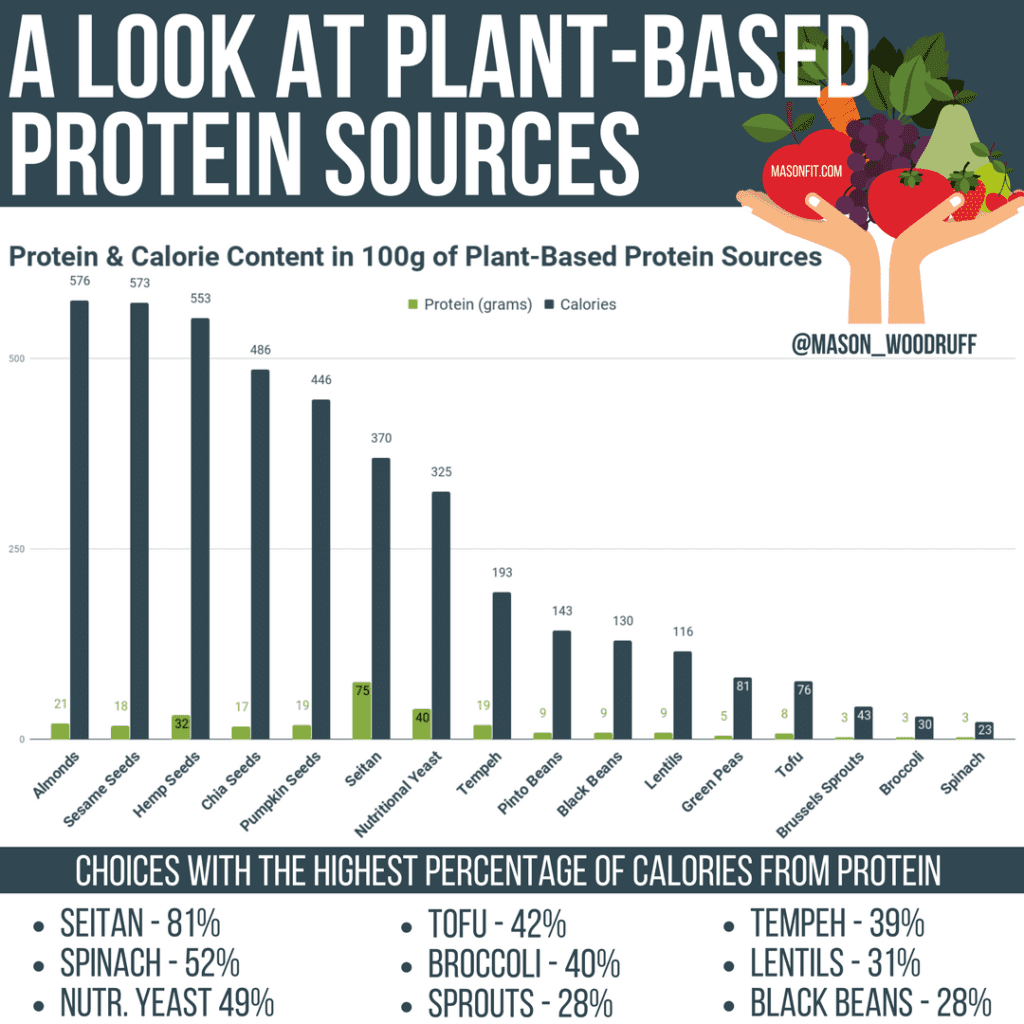
While it’s not impossible to achieve a high protein intake without protein-only foods and snacks, it can definitely be challenging as calorie needs decrease for fat loss. You can think of foods like roasted chick peas, protein bars and cookies, and other pre-packed protein snacks under this same umbrella—any snack that doesn’t have a high percentage of calories from protein (70-80% or more) is likely just a balanced snack instead of a high protein snack.
Using this percentage, you can see that not many plant-based protein sources fit the bill. In fact, only seitan qualifies from the foods above. For this reason, I recommend including some form of plant-based protein powder in a non-animal product diet.
Low Calorie Snacks That Are Primarily Carbs
This section will focus on the crunchy, salty snacks that really embody the work snack in my mind. I’ll cover a few sweet snacks with the recipes below that will really pack just as much protein in as carbs, but we’ll get there. For now, let’s look at some of the best true snack food options when it comes to carbs.
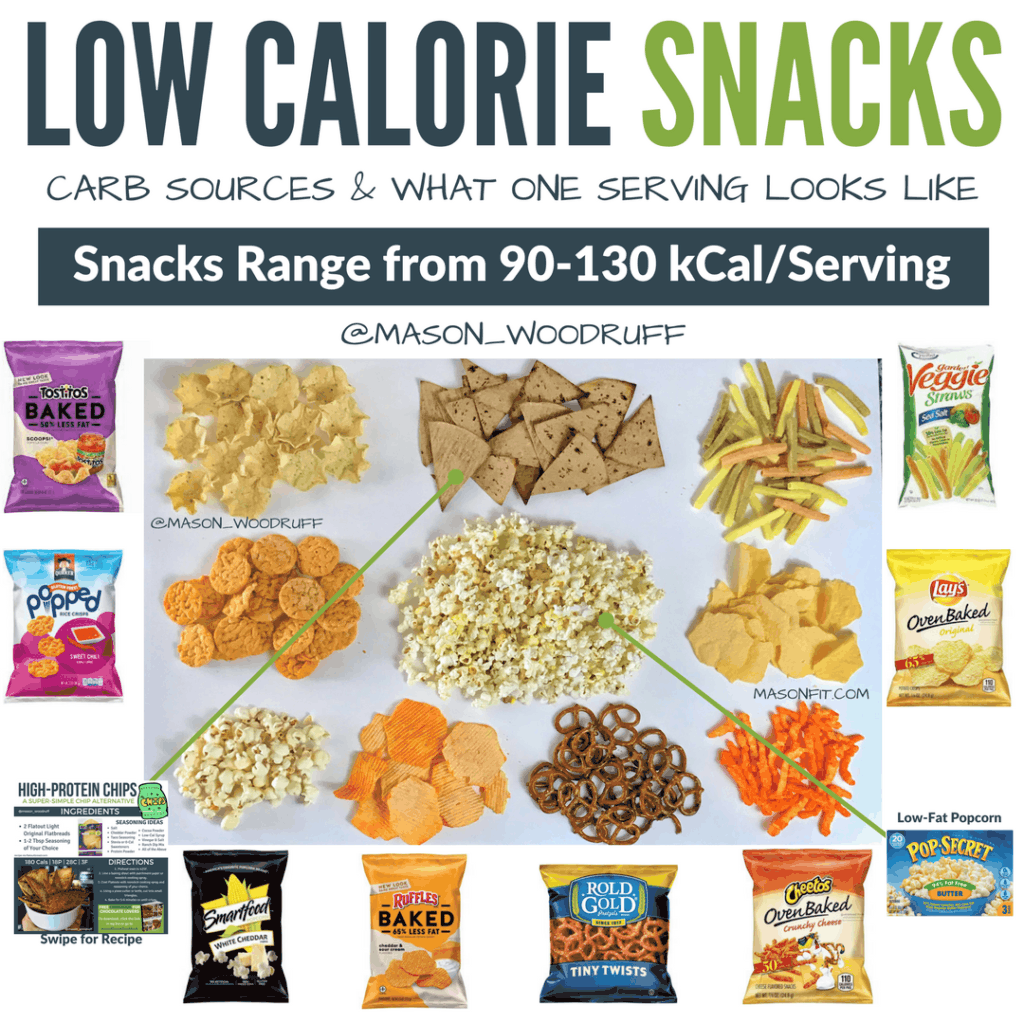
Pay special attention to the volume factor here. The popcorn in the middle, for instance, is significantly more food than the white cheddar popcorn in the bottom right and actually contains fewer calories. These are all great options, but there’s certainly something to be said for being able to eat a higher volume of food and being able to snack for longer. If a snack is super easy to eat and leaves you hungry, that’s not good.
Personally, I find popcorn, pretzels, the Flatout protein chips (I’ll include the recipe below), baked scoops, and even the popped chips take much longer to eat and leave me satisfied with only one serving. Whereas the potato chips like the baked Ruffles, original Lay’s, and veggie straws leave me wanting more.
It’s worth mentioning before we move on, the carb-containing snacks section includes all fruits and vegetables. I won’t include them because they’re a bit of a duh snack. Eat as many fruits and vegetables as you want. I may have thrown shade at plants for their inability to provide protein above, but they’re nutritional powerhouses in terms of micronutrients and maintaining health. Again, eat as many as possible and snack on them until you’re full. Sure, there are a few fruits that contain higher amounts sugar and calories (bananas, avocados, coconuts, dates, raisins, etc.) that you shouldn’t go crazy with but as a general rule, eat as many fruits and vegetables as you want.
Healthy Fats and Snacks for Low Carb Diets
Fats within snacks are tricky. As I mentioned in the intro, fats are essential for health and wellness. Essential fatty acids like Omega-3s from walnuts, avocado, chia and flax seeds, and fatty cuts of fish are some of the more chronically under-consumed nutrients in the American diet. Where it gets tricky, though, is in the calorie content with fat consumption.
For example, a single ounce of walnuts contains 185 calories and 18 grams of fat. Using our example person from the intro, that would be 25% of their daily fat intake. Crazy, right?
It’s extremely easy to overdo it when it comes to fat, and that’s why I like to recommend pre-portioned (or you can portion at home with Ziplock bags) fat sources for snacking. And you should definitely check out my guide to the best nuts for protein to choose the best options.

Just keep in mind, do your best to keep fats and carbs separate unless we’re talking about vegetables or lower calorie fruits like berries. The guacamole and hummus above would go really well with chips from our previous section, but you’d be better off having it with sliced zucchini, peppers, squash, or even carrots.
A single packet of peanut butter would go really well with bread and grape jelly but eating it was apple slices or mixed into Greek yogurt would be much better.
You may have noticed some carryover between the high protein snacks and the high fat snacks in the hard-boiled eggs. There are some fat sources, namely eggs and some dairy, that provide pretty decent amounts of both protein and fat. Even the pumpkin seeds or pepitas have nearly equal amounts of protein and fat. This is great as long as you’re cognizant of how much you’re consuming.
One final note on snacking: Be selective with your fat sources. If you’re using a lower fat protocol, you only have so much to go around, and you seriously need the aforementioned essential fatty acids. The best way to ensure you’re getting an array of these is to consume different foods in your meals and snacks. You may be able to fit 3 ounces of walnuts into your daily fat intake, but you wouldn’t want to do that every day as you might miss out on other fatty acids, vitamins, and minerals.
Combining Ingredients and Macronutrients for Healthy Snack Recipes
Finally, we get to the goodies and recipes. You’ll find a mixture of macronutrient combinations in the recipes below but for the most part, you’ll see a high protein, moderate carb, lower fat, and low calorie/high volume approach. This is primarily because I create recipes based around fat loss diets and eating more food while staying in a caloric deficit. As we just covered in the fat section, it’s difficult to fit a large amount of a high fat food into a deficit.
High Protein Sweet Snacks
You’ll find two graphics below with a total of 8 snack recipes. You’ll notice I use Optimum Nutrition Gold Standard Whey or Dymatize Whey in every graphic, as those are the products I use. You can use any protein you like, but I recommend staying away from isolate protein powder as it doesn’t work as well for cooking.
Also, I use vanilla in every recipe, including chocolate recipes, and get the chocolate flavor from added cocoa powder. If you’d like to skip this step, you can always use chocolate protein powder.You can always turn vanilla protein into chocolate protein powder, but you can’t go the other way. Keep that in mind when purchasing.
Update July 2021: If you’re a newer reader on Kinda Healthy, you know we use PEScience for all our protein powder recipes.
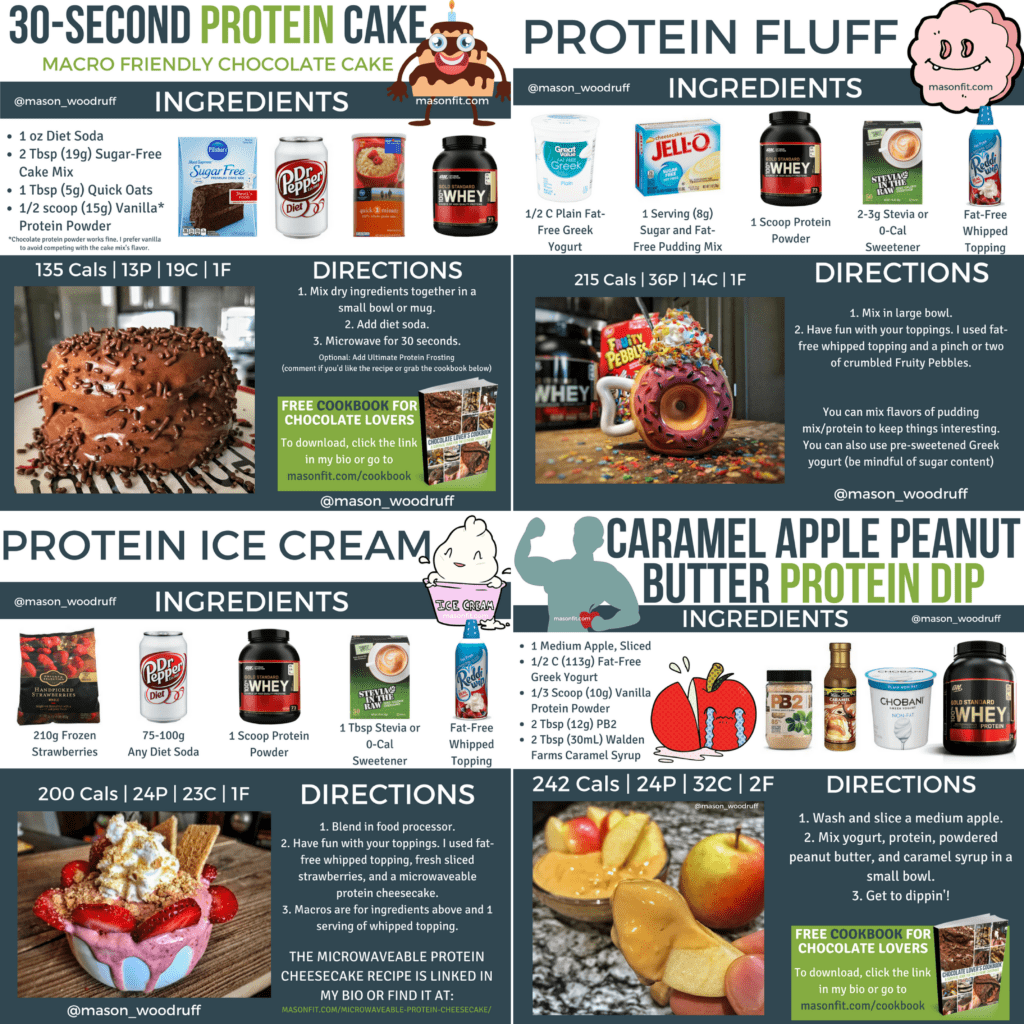
A common question I receive is about the diet soda and whether or not it’s replaceable. I use it as a sweetened leavening agent to add a bit more fluff. You could swap it for any low-cal liquid or water, but you may lose a bit of fluffiness. If you go that route, you could always try adding a tiny amount of baking powder.
And if you can’t find sugar-free fat-free pudding mix or don’t want to keep it on hand, you can always add the equivalent in protein powder. For instance, the chocolate covered strawberries below call for 10g of pudding mix. If you wanted to omit, simply add 10g of chocolate protein powder or maybe 5-10g of unsweetened cocoa powder with 5 grams of protein.
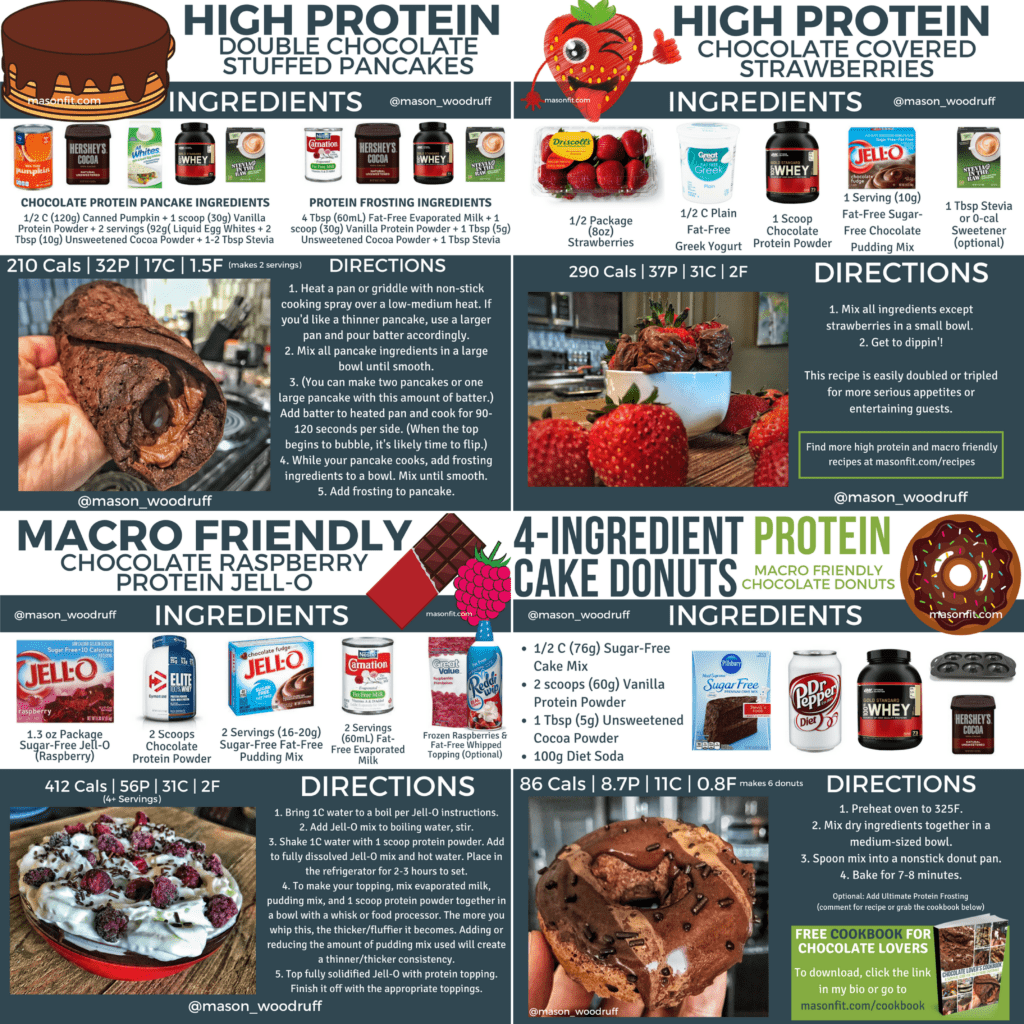
If you take one thing away from this section of recipes, let it be the protein Jell-O. You can’t tell, but the bowl in the picture above is massive. It’s easily one of the highest volume recipes I know of and will both satisfy a sweet tooth and keep you crazy full.
Healthy Chips and Dip Snack Recipes
If I were a lame superhero like Superman, my kryptonite would be chips and dip. Below you’ll find a handful of my favorite alternative recipes. And you thought I forgot about the high protein chips recipe from the carb sources graphic.
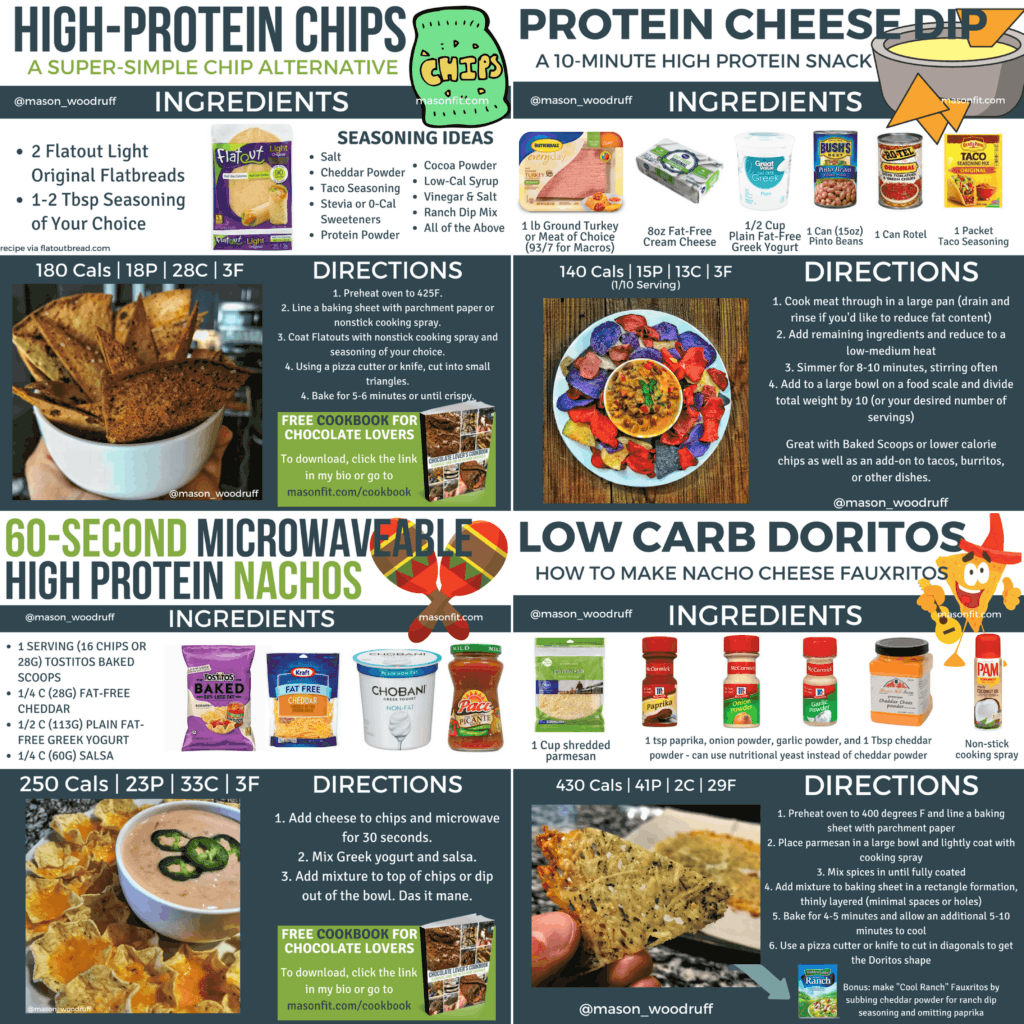
As you can see, calories add up fast when making high fat snacks like the low carb Doritos above. And in this example, you probably wouldn’t want fat from parmesan cheese to be your sole source of fat for the day. Keep this in mind when portioning snacks.
For additional dip recipes, check out my whipped feta dip with 12 grams of protein and 2 grams of fat per serving or high protein cowboy caviar cheese dip.
And for more savory snack ideas, check out my healthy game day snacks recipes roundup or some of the following:
- crinkle cut fries
- air fryer pasta fries
- bacon wrapped jalapeño poppers in the air fryer
- crispy baked tacos
- garlic parmesan air fryer red potato fries
- air fryer carrot fries
Healthy Pizza Recipes for Snacking
Now if I were a much cooler superhero like Batman, pizza would be like the exposed face in my bat suit. It doesn’t seem like a massive vulnerability on the surface, but a blow in this area could be catastrophic.
Thankfully, Flatouts and turkey pepperoni exist. And if you’re wondering, you can use any type of flatbread you like. I’ve found the Flatout light version to have some of the best macros, though. As a reminder, this is where the vegetable point from above comes in. Adding veggies to your pizza snacks and meals is a great way to add micronutrients, flavor, and volume without many calories. So, add them liberally to any of the pizza recipes below.
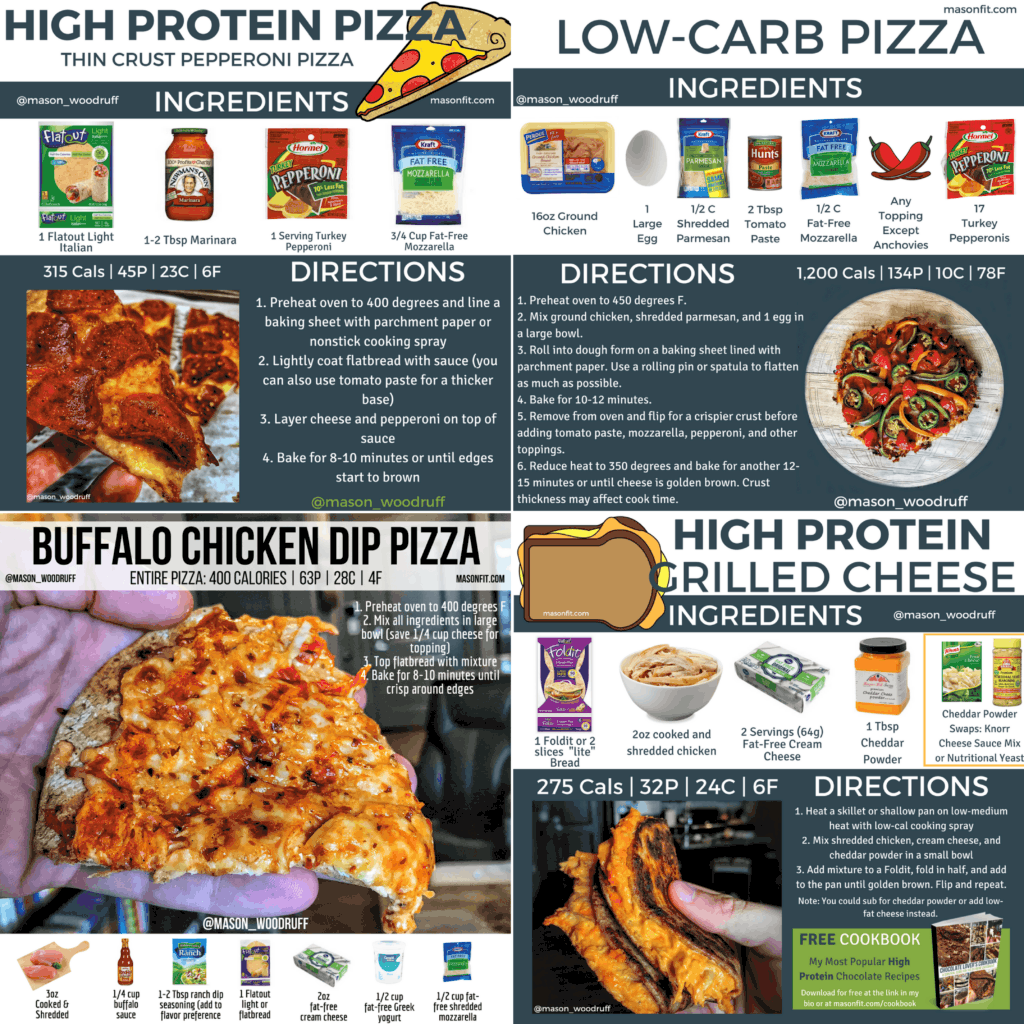
“Whoa, Mason really screwed up here by putting a grilled cheese in the pizza graphic,” is what you’re probably thinking right now. I appreciate your observation skills, but it was intentional. I put the grilled cheese example here simply because I don’t have a graphic for the pizza sandwich I regularly make. You would follow the same directions but swap the cream cheese for fat-free mozzarella and parmesan, either use the chicken and add pepperoni or go with another meat topping, and add a bit of tomato sauce instead of cheddar powder. Boom, you’ve got a grilled pizza sandwich.
More Healthy Pizza Recipes
Rotisserie Chicken Snack Recipes
While we’re on the topic of chicken grilled cheese sandwiches, I thought you might like a few more snack ideas for rotisserie chicken. If you’re short on time or don’t enjoy cooking, buying a rotisserie chicken and a few of the ingredients below could be a game changer for you.
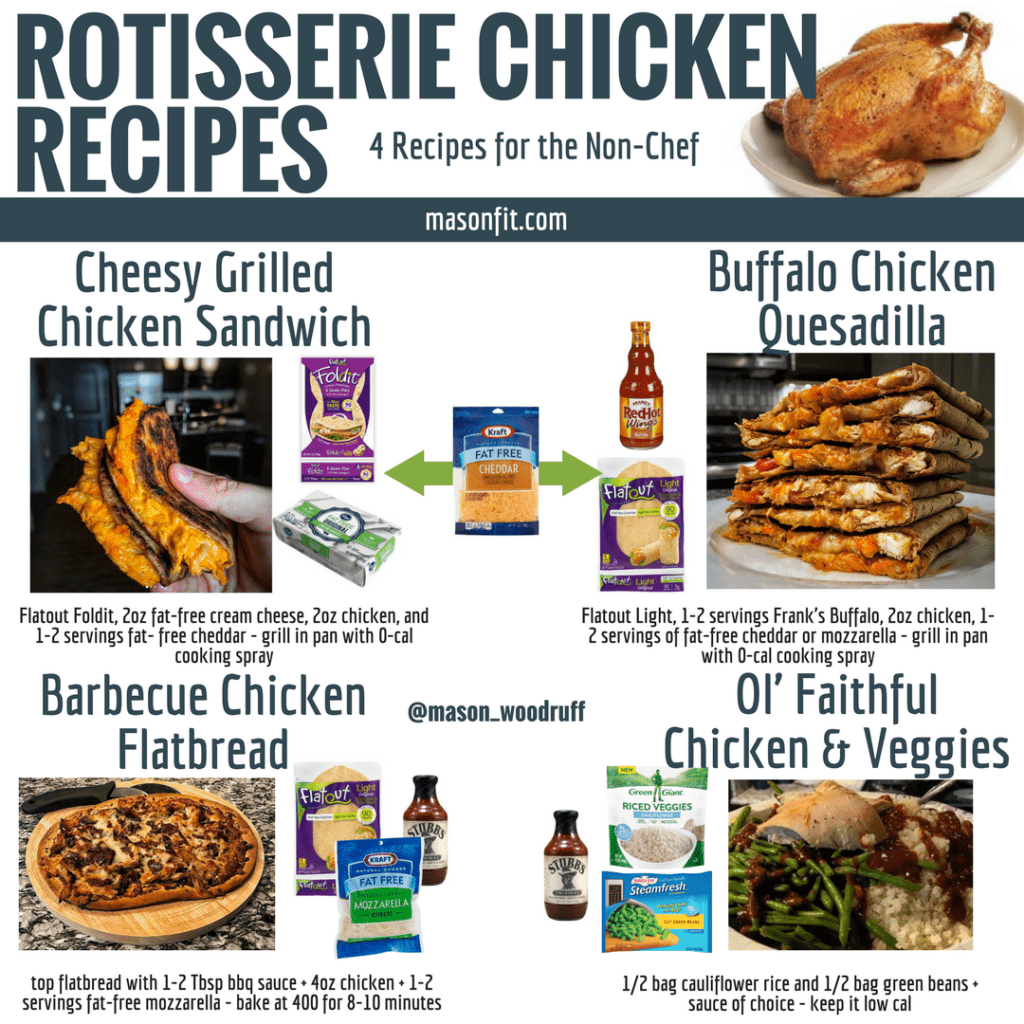
More Recipes with Rotisserie Chicken:
- Healthy Chicken Salad with Rotisserie Chicken
- Chicken and Dumplings
- King Ranch Chicken Casserole
- Buffalo Chicken Stuffed Peppers (you can also make smoked stuffed peppers)
To Make Your Own Shredded Chicken for Recipes:
- Instant Pot Pulled BBQ Chicken
- Pressure Cooker Shredded Mexican Chicken
- Slow Cooker BBQ Chicken Thighs
- Dutch Oven Shredded Chicken
Low Calorie Cauliflower Snacks
Cauliflower is quite possibly the best food on the planet when it comes to making healthy snacks and recipes. I’ve used cauliflower to make everything from high protein skillet pizzas to buffalo wings and protein waffle fries (more on these below). The two recipes below are simple additions to any other snack to bulk up the volume of that snack and keep you full. If you’re wondering what the heck cheddar powder is, read this article to get the 411 and see other recipes.
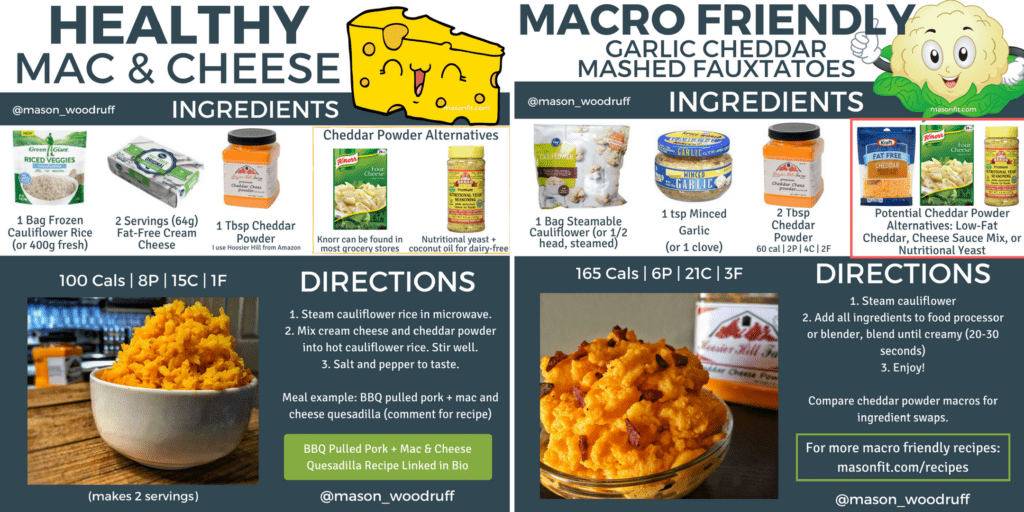
More Recipes with Cauliflower
There’s also frozen cauliflower gnocchi that you can make things like my oven roasted cauliflower gnocchi and garlic parmesan air fried cauliflower gnocchi.
High Protein Popcorn and Candied Nuts for Snacking
You’ve seen both popcorn and nuts in different snack categories above. While they’re both fine snacks for their respective macronutrient categories, I understand the desire to spice things up every now and then.
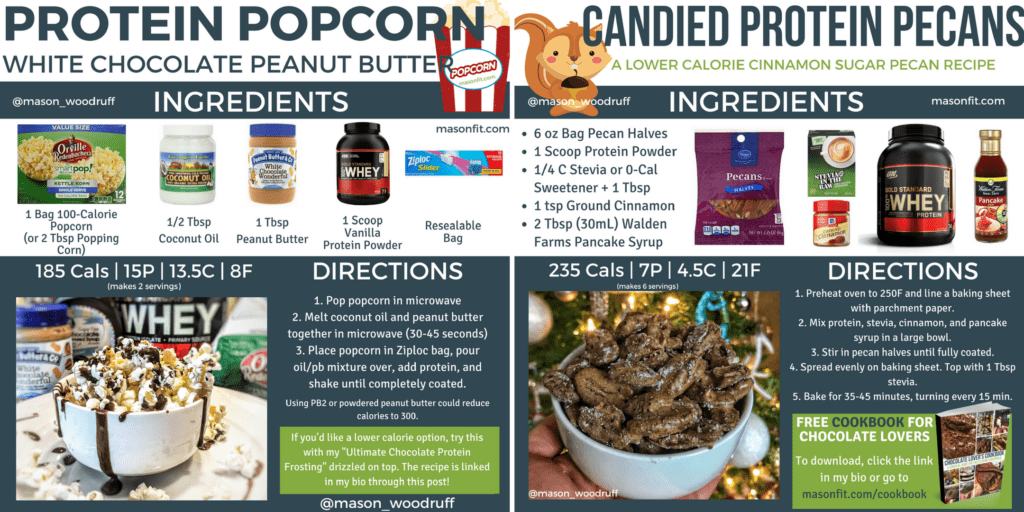
Snack Options for the Mid-Morning Snacker
Similar to leg warmers and tuxedo t-shirts, breakfast never goes out of style. Breakfast is also one of the easiest food genres to make healthy, in my opinion. Egg whites are a low calorie nutritional powerhouse, and protein powder goes with the slight sweetness of most American breakfast dishes. Below you’ll find two of my favorites. And don’t forget about the chocolate protein pancakes above.
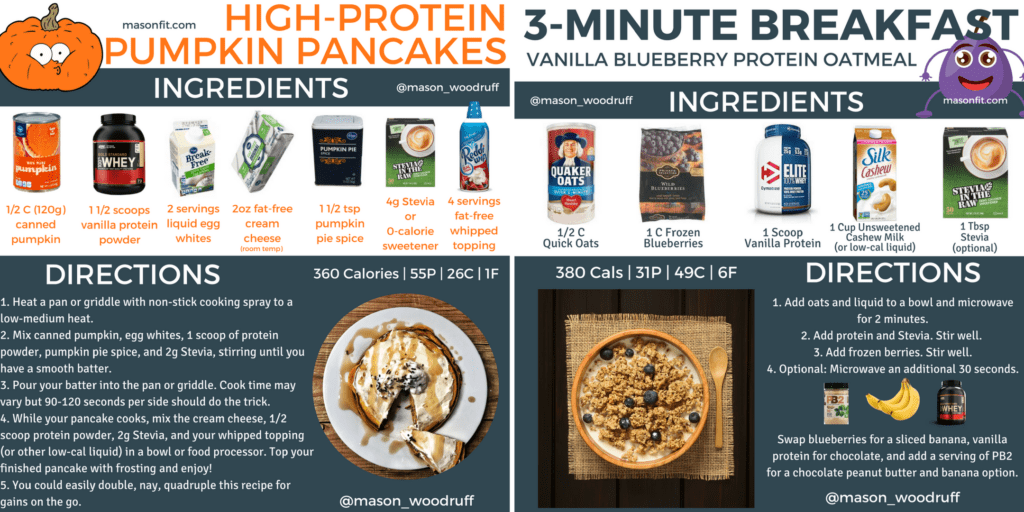
My protein oatmeal and 3-ingredient protein powder pancakes recipes are both super easy snacks to throw together in a few minutes. You might also like prep-friendly recipes like healthy protein granola and low calorie trail mix.
For more breakfast ideas, check out my macro friendly recipes and healthy breakfast recipes for meal prep roundups.
Wrapping Up
You should be well equipped to tackle any diet at this point. I realize I’ve hit you with a lot of recipes and healthy snack ideas in this guide. It’s important to not get overwhelmed by all the possibilities. Implement and experiment slowly and over time, you’ll develop a few go-to recipes and favorites that become a regular part of your diet. That’s it for now. I’d love to hear what you think and would always appreciate you sharing this guide with your friends.
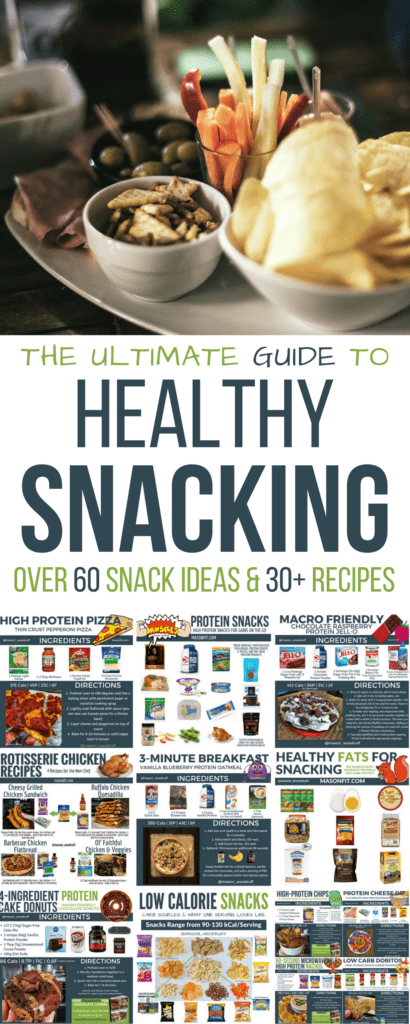

Kelsey P
Monday 12th of April 2021
So thankful your recipes introduced me to cheddar powder! Total game changer! The cheesy Mac with riced cauliflower is perfect without being so calorie dense!
Brandi Franke
Wednesday 13th of March 2019
So I am wondering, if you are counting macros and you say to eat all the fruits and vegis you want, how do you track that? or do you? or how do you adjust your macros to accommodate?
Mason Woodruff
Thursday 14th of March 2019
That's entirely up to you. I'd say it depends on your current fitness level and how serious you are about progress. If you're just starting out, you could certainly get away with not tracking veggies (especially leafy greens and cruciferous veggies). Fruits are slightly different since they can be higher in carbs/calories (look at a banana, for example). But as you get leaner and want to keep getting leaner, tracking everything is a good idea. Not all fruits and veggies are created equally and some may have more calories than you think. I hope that answers your question.